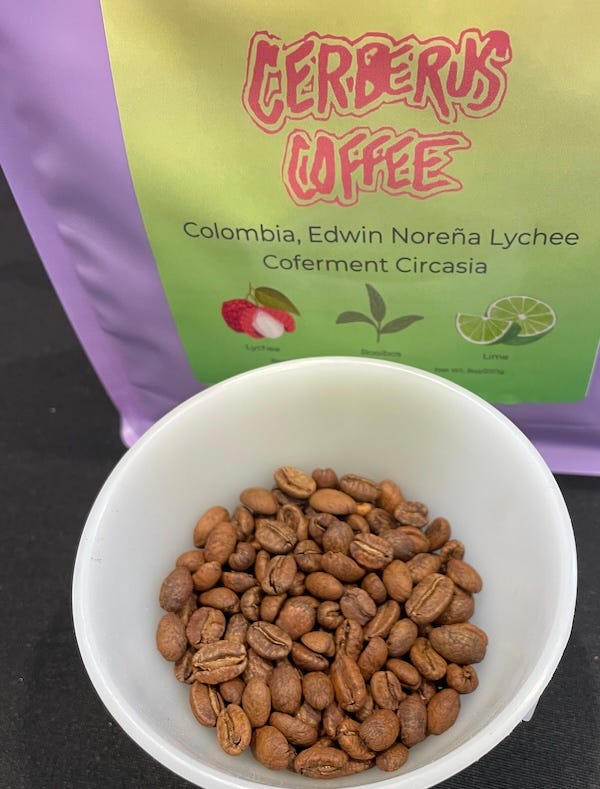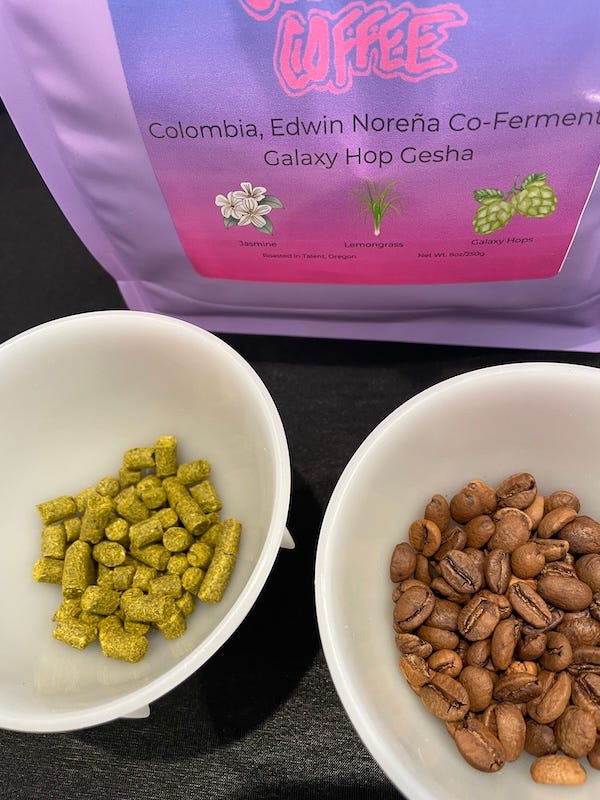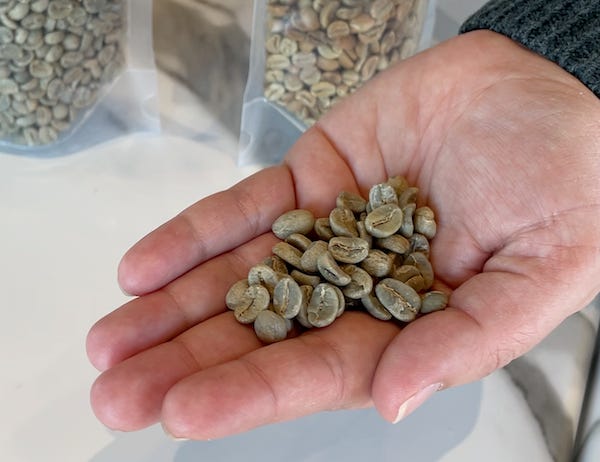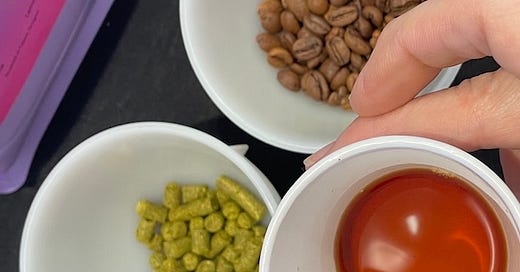Co-fermented Coffee
Coffee processing, baby ducks, and conversation with Cody and Tina at Cerberus Coffee
Coffee is one of those things fermentation educators like to use as an example of a fermented food that people consume all the time, usually unaware that there is a fermentation step involved. This is to entice people who think they don’t like fermented foods into rethinking their position. Chocolate is of course the other…
Today, I thought we would look at that fermentation but take it a step further into the realm of co-fermentation, where, at the moment, there is a lot of innovation and exciting flavor development. (In the future, I hope also to do a post on koji fermented coffee, stay tuned.)
And because today I am watching eggs, it takes surprisingly long. The anticipation is nerve-racking, you can’t help and the duckling inside does a lot of peeping. I would also share this sweet video (sound on) for a little break in your day. 🐣 As of right now five have hatched there are still two peeping eggs.
Okay, back to regularly scheduled programing
A couple of weeks ago, I went to chat with the owners of Cerberus Coffee, a small batch specialty coffee roaster based in Southern Oregon. More than just a coffee shop, Cerberus has created an intentional community space with an openhearted mission. We met at their brand new space, Ceremony. This conversation with Cody and Tina, amazing humans with deep knowledge in coffee and hospitality, focused on the coffee bean and the co-fermentation process to bring out nuanced flavors. The idea for the conversation was born in January when they were tabling two delicious co-fermented coffees at Fermentopia, a local fermentation festival and I tasted the two co-fermented coffees they had. (Video conversation at the end of the post.) They don’t always have co-fermented coffee on hand but you can find their coffee here.


Coffee processing
The coffee bean is the seed inside a bright red fruit called a coffee cherry. (I have never seen fresh coffee cherries, but in the photos, they look a lot like cranberries.) In order to get to the bean, the outer fruit, which is a fleshy mucilage, must be removed. I learned there are many ways to do this, but I will briefly discuss the three main processes, so that you can see where co-fermentation fits in.
For comparison, let’s look at the other common ways coffee is processed. Natural/Dry, wet, semi-dry processes, and anaerobic processing each involve fermentation to some degree to break down the mucilage—the sticky layer between the fruit pulp and bean. We looked closely at the three sample green beans that Cody brought. Cody shared that by looking at them, he can tell what kind of processing they went through.
Natural (or Dry) processing

Natural/Dry processing is the oldest and most traditional method. Coffee cherries are picked and spread out in the sun to dry over several weeks. The bacteria and yeast ferment the sugar of the fruit as the fruit is drying. This produces fruity, more complex flavors.
Washed (or wet) processing

Washed/Wet processing came about in response to trying to get a more consistent product in the 19th century but gained popularity in the 20th century when farmers started using de-pulping machines. As you might guess, the pulp and mucilage are removed. The beans are then soaked in tanks of water for up to two days, where the residual fruit and mucilage undergo fermentation to remove this remaining bit. Fermentation here is for removing the mucilage, not about flavor development and adding value, which we will talk about in a moment. This fermentation also breaks down sugars and flavors, producing a cleaner, brighter, more acidic flavor.
Honey (semi-washed) processing

Honey/Semi-washed processing in a newer method that combines both the wet and dry methods. It is called honey, not because there is any honey involved but because the beans have a sticky texture. In this process some of the fruit pulp is left on the bean to ferment and dry. The mucilage is still intact. The bean is then left to dry. To ensure even drying beans are turned regularly. This process retains fruity notes and can also be sweet.
Anaerobic fermentation takes oxygen out of the mix. Some producers leave the cherries whole with the fruit intact while others remove it. Without oxygen a different range of yeast and bacteria do the work, again affecting the final flavor profile.
Co-Fermented Coffee
Co-fermented coffee means that the beans are fermented with other ingredients. These can be other fruits, herbs, spices, or even specific yeast strains. When Cody explained how fruits were sometimes explicitly used to harvest yeasts for the co-ferment, Tina referred to our Cidermaking book’s section on harvesting wild yeasts for their unique flavor stamp when making ciders. It's the same thing they said.
Fruit can be added for both their own unique yeast profile they bring to the ferment and the fruit’s unique flavor and sugar. If you think of it as a party (which is always the easy metaphor, as yeast are so lively and create alcohol), this party is a happening scene. There are many diverse guests (yeast and other microbes) that come in on the skins of the coffee and fruit, but when adding other fruit in particular, a significant amount of food, minerals, and nutrients to fuel the fermentation, like bringing more pizza and beer to the party. These additions then become a catalyst for a whole lot of flavor to happen.
Co-fermentation is another way to tweak any of the above processing methods. I like to think of each type of fermentation as having many dials to turn in order to achieve what you want. Co-fermenting with a dry, wet, honey, or anaerobic method will each produce unique environments for the microbes to impart their help and flavors.
If the co-ferment happens in the natural/dry processing the other ingredients are added mixed in with the coffee cherries and dry and ferment along side them. In the wet process the fruit or other ingredients are put in the tank.
If the idea is to bring forward more fruity notes, the maker will add fruit, for example, the lychee co-ferment I tasted had the lychee notes alongside the coffee’s own fruitiness. Spices might bring forth earthy and aromatic flavors. The other one I tasted was the coffee co-fermented with Galaxy hops. It was mind-blowing; the coffee’s own fruitiness and bitter notes were enhanced with the tropical fruit and distinctive aroma of hops. And no, this isn’t your morning cup but your special occasion cup, like sitting down in the early afternoon with friends.
In recent years, coffee fermentation has started to look at yeast strains and what flavors these strains contribute to the flavor of the coffee, much in the way wine or beer have for decades. This process introduces nuanced flavors and adds a lot of variety to the taste of the coffee. The process brings complexity and layers to the flavor of the coffee, and the two that I have tasted, I must say, have a light body with a natural sweetness that I have not tasted elsewhere—even the hoppy one.
Basic Steps in Co-fermentation
The coffee cherry is fermented whole with an additional ingredient, like galaxy hops. Sometimes the cherries are fermented alone for a period of time before the ingredient is added, other times the co-fermented ingredient is added from the beginning.
Once this fermentation is complete, the coffee is dried. This stabilizes it before roasting.
We talked a lot about how this process allows the coffee producer to have more control over their product’s flavor and uniqueness. This is a way that producers can work with their beans to make more money on the crop. It is a fairly new process and still evolving as producers experiment. And as with any fermentation, a risk to the producer, in that things can turn out not as hoped. However, as producers are learning and sharing knowledge this is becoming an exciting space in coffee.
Keep reading with a 7-day free trial
Subscribe to Fermenting Change to keep reading this post and get 7 days of free access to the full post archives.






